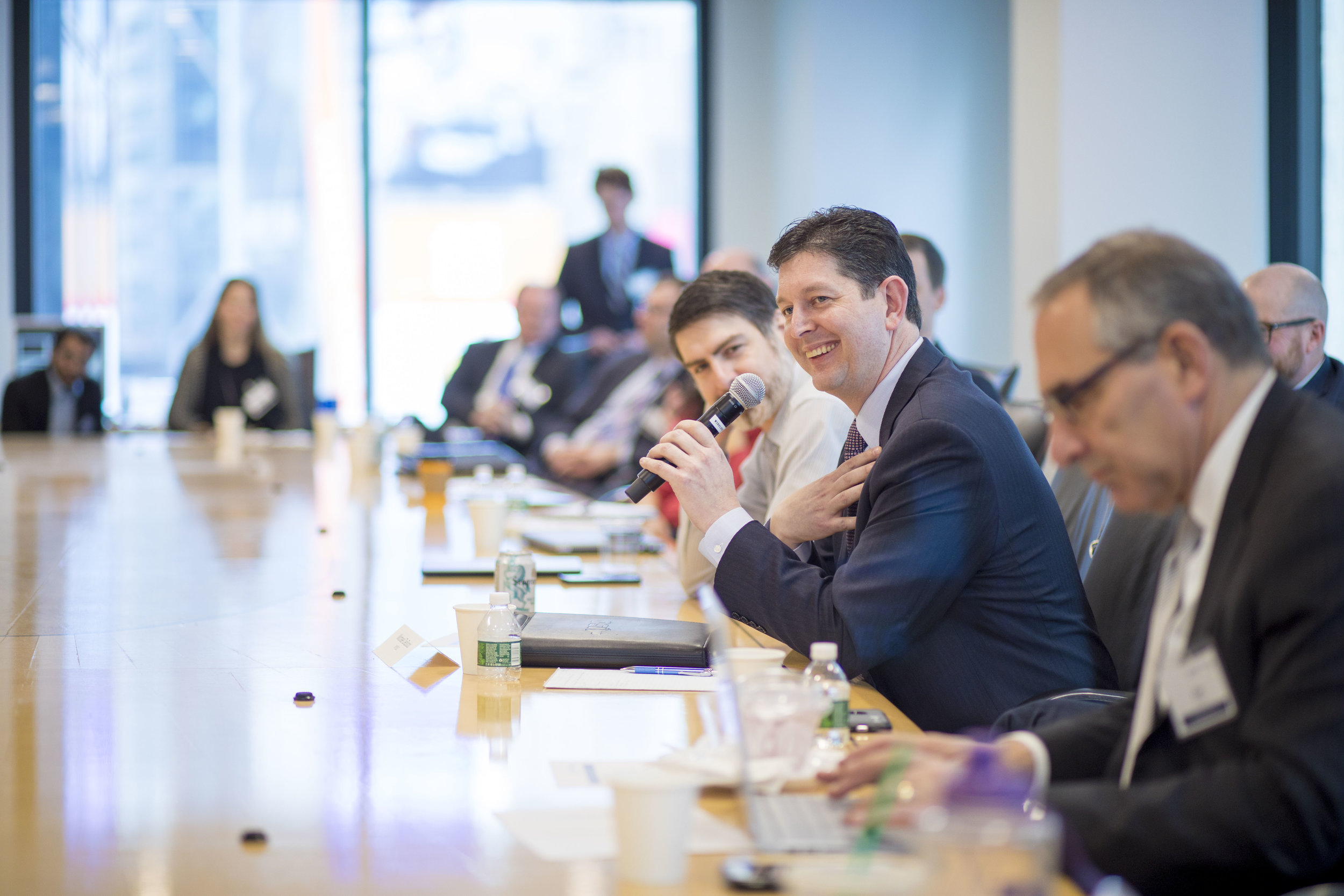-Jude Buenaseda, AEG Fellow
Highlight Video - NYAE Q1 2018
With the recent nor’easter storm leaving over half a million people without power, the Q1 2018 Stakeholder Breakfast on the topic of Resiliency, Critical Infrastructure & Microgrids couldn’t be timelier. New York Advanced Energy welcomed discussion leaders:
Susanne DesRoches, Deputy Director, Infrastructure + Energy, NYC Mayor's Office of Recovery & Resiliency
Michael DeSocio, Senior Manager, Market Design at NYISO
Paul Tyno, Strategic Advisor Energy Initiatives, Buffalo Niagara Medical Campus
Damei Jack of Manager, Strategy, Distributed Resource Integration, Con Edison
The stakeholder member discussion highlighted the importance of critical thinking, brainstorming, and planning for the future to anticipate future disasters, prevent crises, and recover from them quickly.
The discussion leaders presented their respective organizations’ projects and plans to improve energy efficiency, sustainability, and resiliency in the city’s infrastructure. From New York City’s 80 x 50 framework on reducing greenhouse gas (GHG) emissions by 80% to a more connected electric grid and additional distributed generation development, there are a lot of challenges that come with these objectives. Collaborating with different entities that have similar goals towards the city’s energy landscape and engaging in productive dialogue, in forums like AEG’s stakeholder breakfasts, are examples of effective methods organizations can participate in to innovate and develop solutions collectively. Achieving the city’s resiliency goals is not easy, but it will have a significant impact on the quality of life of New Yorkers and prevent productivity disruptions from extreme events.
Phyllis Kessler of Duane Morris was first to address the audience and she asked how the city provides critical infrastructure for energy supply and how does it differ from federal to local levels and from utilities to customers. She then highlighted the importance of preventing storm surges and other weather-related risks from damaging infrastructure (hardening). Phyllis encouraged distributed generation from cogeneration to battery storage and to review what measures work best for the security of supply while still limiting greenhouse gas emissions.
Susanne DesRoches, deputy director of Infrastructure and Energy at the Mayor’s Office emphasized three things; the aftermath of Sandy, how we look at vulnerability now, and how these things mesh with the city’s GHG reduction goals. After Superstorm Sandy hit in 2013, New York City developed “Stronger More Resilient NY,” a plan with 257 initiatives to recover from the storm and rebuild communities stronger than before. Since then, there has been a fair amount of progress leading up to many smaller projects within the framework, such as the East Side Coastal Resiliency Project (ESCRP), which is strengthening coastal defenses, upgrading buildings, and making neighborhoods safer. The initiatives look into other risks besides storms – heat, for example, kills over 100 people a year in New York City and causes a lot more stress. The Cool Neighborhood Report illustrates specific strategies that are implemented city-wide on how things hold heat and prepare for less vegetation.
New York City also runs the Climate Change Adaptation Taskforce monitoring sea level, temperature, and assets to provide info to the city. The analyzed data is extrapolated from now up to 2100s and projected sea level rises range from 10 to 72 inches. With that size of a gap, a more detailed and more in-depth analysis is taken into account on incorporating sea level rise in the city’s resiliency guidelines.
Susanne also displayed the city’s renewable energy goals with 1,000MW solar power capacity by 2030 and 100MWh of storage by 2020. The goals are well on their way, but each step gets harder than the previous. She also highlighted the need for investment in offshore wind and its mass potential for contributing to New York City’s clean energy profile, which most recently includes an upcoming 400MW offshore wind procurement as part of the New York State Offshore Wind Master Plan.
Michael DeSocio, senior manager at New York Independent System Operator (NYISO), spoke on critical infrastructure and the January ‘98 upstate ice storm when the power went out for almost three weeks. The area that was affected is now installing a microgrid to prevent future disasters like the 1998 upstate ice storm. The microgrid will use local renewable resources as much as possible and will be the nation’s largest municipal microgrid. The proposal calls for 3 megawatts (MW) of combined heat and power generators, 2 MW of solar PV, 2 MW of storage, and 900 kW or more of hydropower.
Michael discussed the urgency to enable a larger marketplace to make resiliency more affordable. Customers normally do not choose their energy provider and go with the default choice without exploring other options. Michael also added important NYISO activities including carbon pricing and ancillary services to help New York reach its renewable goals. There was discussion on the 1,000 MW threshold for energy storage systems to participate in ancillary service markets.
Michael also mentioned NYISO’s DER Roadmap and State of Storage reports, which include uses of energy storage and microgrid technologies to benefit customers and the distribution system. Transitioning from a traditional, one-directional electric grid, to a bi-directional flow of electricity will alter New York’s infrastructure and improve the system’s resiliency and fuel diversity. The reports also show how to manage chaos and resiliency in the presence of clean energy.
Paul Tyno, strategic energy advisor of Buffalo Niagara Medical Campus (BNMC), shared his expertise on the energy industry as he laid out the master plan for BNMC partnered with National Grid. With 17,000 people on campus and medical equipment that can have life-threatening implications from energy disruptions, critical energy infrastructure must be prioritized. At medical institutions, power quality and resiliency requirements are much higher. With the development of a microgrid, BNMC became a self-sustaining energy hub, enabling back-up energy supply in the event of a grid outage. Paul noted that a microgrid is not the end point and that energy systems are always evolving, customers will continue to adapt and it is essential to stack projects to the broader systems. Conversations between policy makers, energy providers, and customers is essential.
Damei Jack, Manager of Distributed Resource Integration at Con Edison, presented the implementation of non-wire solutions. From energy efficiency and distributed power generation, Con Edison is upgrading from traditional systems to a more reliable and cleaner energy system. The Brooklyn Queens Demand Management Program (BQDM) is one of the non-wire solution projects, identifying North East Queens and Brooklyn with significant growth and a need for load deductions. Con Edison is collecting data and outlining how to implement more non-wire solutions from both the utility and customers’ standpoint.
Leo Subbarao, FDNY Sustainability Unit Manager/APM, discusses progress in testing and approvals for lithium ion energy storage systems
Lastly, New York Advanced Energy’s Executive Director, HG Chissell, started the open discussion part of the morning by centering on a future scenario where New York City has reached its resiliency goals. While focusing on the steps needed to develop a stronger city, the central question was “what were the three most impactful things we did?” The stakeholders came to a consensus linking back to the speakers’ points and agreed on the importance of getting price signals and financial incentives correct, how to develop new transmission from upstate to downstate – in light of the challenge of Indian Point closing - and creating a better relationships with consumers. Members of the FDNY led discussions around lithium batteries and their testing for approved outdoor use. The development of energy storage is critical to the future of New York City’s energy infrastructure and resiliency. In the end, it was apparent that all the stakeholders involved in New York City’s critical infrastructure are working towards building a more resilient city.
Q2 NYAE Stakeholder Breakfast will be held on May 24, 2018 on the topic of: Smart Buildings and Grid Modernization. More details can be found here.
Advanced Energy Group is a stakeholder member-supported organization committed to developing and delivering advanced energy policies and solutions in key cities. Stakeholder sessions are by invitation only. For details of our programming please visit:
AEG Event Calendar | Podcasts | Videos | LinkedIn | Twitter







